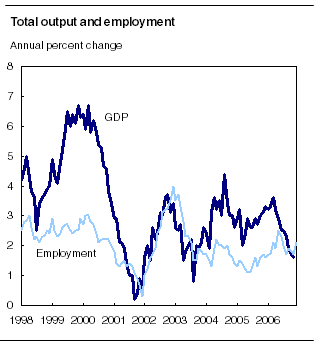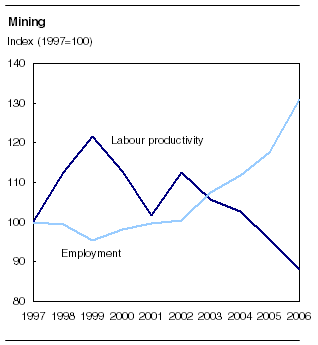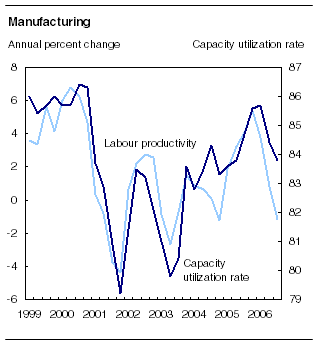Common menu bar links
Study: Recent trends in output and employment
Archived Content
Information identified as archived is provided for reference, research or recordkeeping purposes. It is not subject to the Government of Canada Web Standards and has not been altered or updated since it was archived. Please "contact us" to request a format other than those available.

Several economic and statistical reasons explain why labour productivity did in fact slow last year, according to a new study.
The study examines reasons for one of the major economic developments in 2006 — the slowdown in growth of output, accompanied by steady gains in employment.
Typically, output exceeds employment growth by over 1%, reflecting the upward trend of productivity. The convergence of output and employment gains late in 2006 implied a slowdown in the growth of productivity. This study attempts to clarify why this happened.

It points to a number of reasons. First, growth nationally shifted to industries where productivity declined, notably mining. Many industries, especially in Western Canada, are struggling with labour shortages.
Note to readersWhen this paper refers to productivity, it refers to gross domestic product (GDP) per hour worked in the business sector, rather than output per employee. Unless otherwise noted, the employment data in this paper came from the Labour Force Survey. Total output refers to aggregate real GDP, including both the business and non-business sectors. |
In addition, employers hired less-skilled labour and spent more time training employees. And finally, more industries were affected by one-time events last year, such as disruptions in the mining sector and a record warm winter that curtailed production.
Analysts treat output per employee and labour productivity as inter-changeable concepts. However, there are differences that can cause these series to diverge over time.
Most important is that the official labour productivity data cover only the business sector, which excludes the 15% of gross domestic product (GDP) in the non-business sector. As well, productivity is calculated as output per hour worked, not output per employee.
The cyclical setting
Output often slows relative to employment growth for short periods of time outside of recessions. As recently as 2002 and 2003, output growth fell farther below job growth and for a longer period of time than in 2006.
In fact, a narrowing of the gap between total output and employment growth has been the rule, not the exception, since the economy began to recover late in 2001.
Year-over-year growth in output per employee was negative for 14 of the 26 months between July 2001 and August 2003. Output struggled to keep up with employment growth a majority of the time: falling behind late in 2001, barely keeping ahead in 2002, and slipping below again in much of 2003.
Only in 2004 and 2005 did output growth clearly exceed job gains, implying positive labour productivity growth. Even then, the productivity gains were far short of those in 1999 and 2000. So the convergence of the two again late in 2006 is hardly a new phenomenon.
Nor is it unusual for Organisation for Economic Co-operation and Development (OECD) countries to experience two (or more) years of little productivity growth. Just since 2000, 10 of the 29 OECD countries for which data are available experienced such an episode. Interestingly, Norway and Australia are both currently experiencing little or no growth in output per employee, and like Canada, both have large natural resource bases, which is the source of much of the productivity slowdown in Canada.
Industry trends
A more detailed analysis of the industries within the goods-producing sector shows almost all posted lower productivity during the first three quarters of 2006. Output per hour worked declined by nearly 10% in the resource sector, by itself shaving a full percentage point from productivity growth in 2006. Mining led this drop, as output grew slowly while employment raced ahead by over 10%, the most of any industry in 2006.
Last year's drop in mining productivity was part of a long-term downward trend. The declining productivity of conventional wells and the shift to lower-productivity output from the oilsands is reflected in a 25% drop in labour productivity in mining since its peak in 1999. Most of this reflects a 60% hike in employment in the oil and gas sector, almost all in Alberta. The employment increase in mining was led by the oilsands, which hired thousands of workers on mega-projects that will not begin producing oil for years.

Mining outside of oil and gas is also increasingly located in remote parts of the country or requires digging deeper into the earth's crust. The best example is diamond mining, which currently is located exclusively in the Northwest Territories.
Some of the drop in productivity in metal mines reflects the exhaustion of the most productive sources, just as was the case for conventional oil and gas. The most obvious example is gold mining, where annual output has fallen steadily since 2001, including a 25% drop over the last two years (despite higher prices). Several of the largest mining industries experienced production difficulties last year. None of these problems have recurred so far in 2007, so some recovery in productivity can be expected.
Output per employee declined in manufacturing in 2006, following two years of growth. Factories so far this decade have not come close to matching their stellar productivity gains during the high-tech boom in the late 1990s.
The downturn in manufacturing productivity in 2006 reflects a slump in output, which lowered capacity utilization (the main determinant of productivity in the short-term). Manufacturing output fell 4.8% in the first 10 months of 2006 (it recovered slightly at year-end), and productivity typically falters during contractions.

Overall, output per employee in services escaped the large deceleration recorded for goods. Several industries posted solid gains, notably consumer-related industries, which benefited from strong demand. Still, growth was restrained by a shift to public and business services, where productivity growth is limited by definition.
Labour quality declined
Several measures show declining labour quality, especially in Western Canada, where employers faced severe shortages. Employment rose faster last year for the youngest and oldest segments of the population — the least productive — than workers in their prime (between 25 and 54 years old).
Nation-wide, employment rose faster for people 55 years and older (+6.7%) and youths (+1.5%) than for middle-age workers (+1.4%). As a result of increased demand, the unemployment rate for youths hit a record low of 9.7% by last December and both the employment and labour force participation rate of people 55 and over also hit record highs.
Shortages induced employers in Alberta and British Columbia to turn the most to the youngest and oldest to fill jobs. In Alberta, the increase was most pronounced for youths while British Columbia was more reliant on older workers.
In Alberta, people with high school education or less accounted for over half of all employment growth in 2006. This was by far the most ever, and a marked change from the 1990s when employers showed a marked preference for people with more than high school education.
Business investment points to better productivity growth. Fuelled by record high profits, firms have stepped up investment outlays by a steady 10% in each of the last three years.
It is rare for productivity to slump for an extended period when investment is expanding. This is encouraging for a rebound in productivity growth in the short run, holding out some prospect that the current slump will not be as prolonged as in 2002 and 2003. One factor that may explain the divergence of investment and productivity in 2006 was that so much of investment was driven by the energy sector, where the pay-off in higher output will not materialize until later.
The major question at the moment is not whether a slowdown in output relative to employment is occurring, but whether this slowdown is transitory due to temporary factors (related to events such as weather, other production disruptions, or the sudden shift of resources to new industries and regions), or represents the beginning of a longer-term slump in productivity due to labour shortages, an ageing labour force or structural changes in the economy.
Definitions, data sources and methods: survey numbers, including related surveys, 1402, 1901, 3701 and 5042.
The study "Recent trends in output and employment" is now available as part of the Income and Expenditure Accounts Technical Series (13-604-MIE2007054, free) from the Publications module of our website.
For more information, or to enquire about the concepts, methods or data quality of this release, contact Philip Cross (613-951-9162; ceo@statcan.gc.ca), Current Economic Analysis Group.

